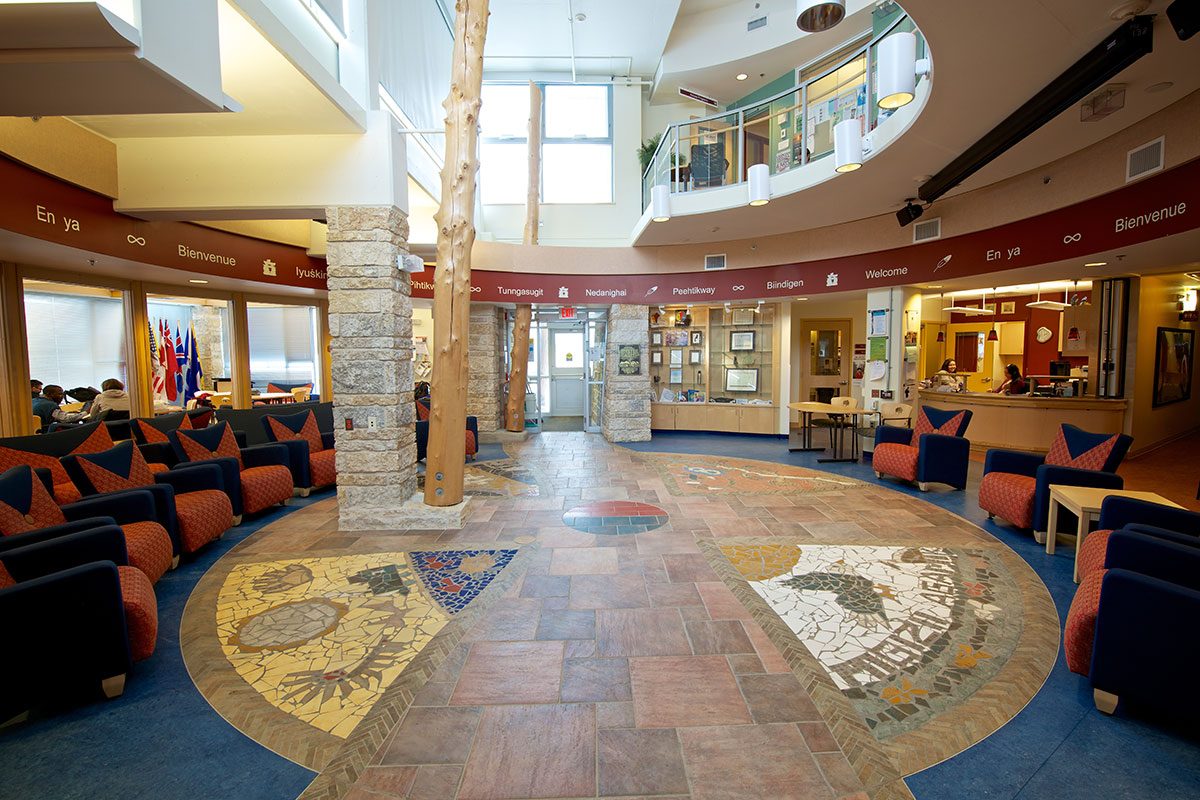
Migizii Agamik – Bald Eagle Lodge.
Building Migizii Agamik – Bald Eagle Lodge
This is the second in a series of articles about the creation of Migizii Agamik – Bald Eagle Lodge. Click here to read the first article.
Upon entering Migizii Agamik, visitors are greeted with the words “pihtikwew, biingigen, en ya, peehtikway, iyuśkin kuwa, and tunngasugit.” These translate to “welcome” or “come in” in the languages of the seven Indigenous groups of this territory – Cree, Anishinaabe, Dene, Oji-Cree, Métis, Dakota and Inuit.
Carl Stone, a cultural and student advisor at the Indigenous Student Centre (ISC), says when Migizii Agamik was being designed, the building committee stressed the importance of having all seven groups represented within the space.
In fact, most elements of the building’s design carry cultural teachings. For example, the colours blue and red are found throughout the building.
“The blue is connected to water and the moon, which is connected to women. The red is connected to fire and the sun, which is connected to men,” says Stone. “The moon has an effect on the waters of the earth, in the same way that women have a cycle within themselves that’s connected to the moon.”
Other cultural aspects inside the building include the 13 beams above the student lounge, which start in the east and are symbolic of the 13 times the ‘Grandmother Moon’ is full annually. The four directions are also acknowledged, with the doorways of the lounge facing a true east and west, welcoming all people.
The building’s Circle Room reflects the shape of Mother Earth. When being designed, the door of the room was shifted to open counter-clockwise, as the sun travels clockwise.
“If you ever notice me, whenever I enter a tipi or a sacred lodge, I’ll always enter clockwise,” Stone says. “It’s about teaching respect, and keeps us engaged in following the rules and being aware of what we were given.”
A leader in sustainable design
Migizii Agamik was the first building on campus to receive Leadership in Energy and Environmental Design (LEED) Gold certification for its green building strategy.
Water use within the building is 52 per cent less than average, thanks to features like automatic faucet shut-offs and waterless urinals. The building also has daylight and occupancy sensors to achieve an energy performance that is 39 per cent better than current building standards.
The plants and grasses that surround the building are native to this region and are tended to without the use of harmful chemicals or conventional irrigation. Natural materials like stone and wood are also present throughout the building, strengthening the organic approach.
“[Being a LEED building] was really important to us, especially as Indigenous people, because a lot of us come from smaller communities and are quite aware of what it means to be in nature and to live in nature and with the environment,” says Brenda Lee Lafreniere, who has worked for the Access and Aboriginal Focus program for 22 years.
“This building, for me, just enhanced my understanding of protecting the environment, and I was very proud of that.”
Building committee
In March 2008, Chief Arvol Looking Horse, Elder and keeper of the Sacred White Buffalo Calf Pipe, blessed the building during the annual Elders Gathering.
“Due to the construction, we were told that we would have to wear safety boots, hats and gear to enter the building – making ceremony very difficult,” says Kali Storm, who was director of the Aboriginal Student Centre at the time. “Instead of cancelling or postponing, the university and the construction crew took that time off so we could enter. This is when I knew that something special was happening.”
Lafreniere was also present for the ceremony, and says it’s one of her fondest memories.
“The energy was pretty beautiful,” she says. “We all sat on the floor on cushions, and after that it was a good feeling. That, to me, was the true opening of the building, because you blessed it and it became something.”
A few months later, staff moved into the building. During that time, a building committee was formed. It included Lafreniere – the interim director for the Access programs at the time – as well as Storm and Dr. Fred Shore, assistant professor in the department of Native Studies. Three Indigenous students were later added to the committee.
The group’s duties included finances, building upkeep and everything in between. One of their largest tasks was to Indigenize the building exterior, examples of which include road signs with different community names and the distance of those communities from the U of M.
“We were quite adamant that everything should be student-led,” says Lafreniere. “There were a couple of days where the students would come and paint the names of their community, and then the kilometres were translated by [former Aboriginal Student Centre employee] Bev Getty.”
The poles outside, which detail the seven major Indigenous groups in the province, were one of the last initiatives.
“Our most important thing was how to respect all the nations that come through the building, inside and outside,” says Lafreniere.
Read the third article here on Migizii Agamik – Bald Eagle Lodge.
Join us for Indigenous Homecoming on Sept. 26.







This is a beautiful article. And the foye is spectacular. Thank you.